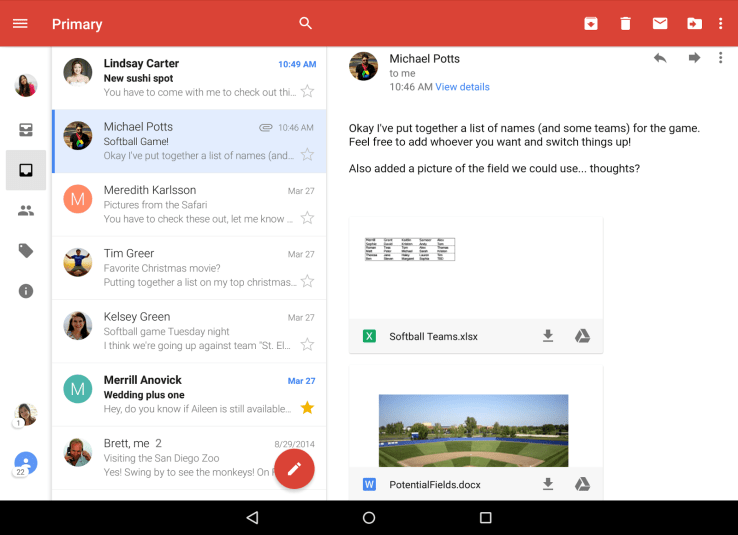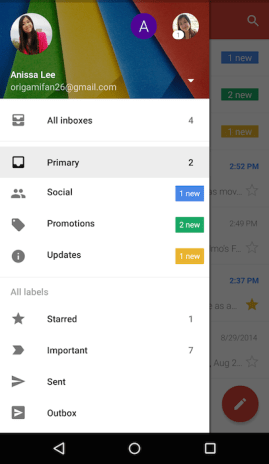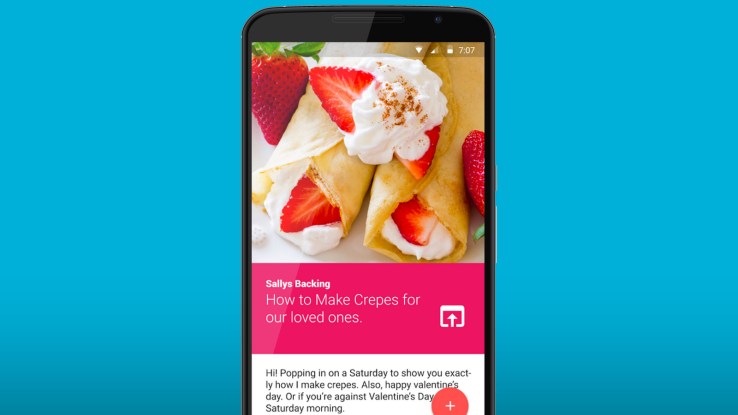Biddulph And Coates Launch Thington, A New Super-Angel-Backed IoT StartupA number of companies today leverage the ubiquity of smartphones in order to offer parents “connected” baby monitoring systems that can be accessed from anywhere. Often, as with devices like NapTime or Evoz, these include a monitor and camera of some sort and an accompanying mobile app. But a startup called Dormi has historically offered a different take – instead of selling new hardware, the company allows you to re-use old Android smartphones or tablets in order to remotely monitor your baby’s room.
Now its system has received a long-anticipated update, with the much-requested addition of video monitoring.
Previously, Dormi’s system was audio-only. Using an app that worked over Wi-Fi or cellular connections or even WiFi Direct/WiFi Hotspot, you could listen in on baby while out of the room, much like traditional baby monitoring systems allow for today. You could also press a button to speak into the app which would transmit the sound of your voice to the other device in the child’s room.
The devices you use with Dormi could be an extra Android phone or tablet you had lying around the house. Or you could use your current Android device as the primary one, if you chose.
In addition to the simplicity of the system, the app has been priced compellingly – perhaps even too cheaply considering its hardware-based competition sold through baby superstores and other retailers is often exorbitantly priced.
While technically a subscription-based app, Dormi offers lifetime usage for just $7.00. It’s sort of a no-brainer for those looking for simple and affordable alternative to traditional baby monitoring systems, or just wants a solution that’s easier to carry around when traveling, for example.
 4YJmy4N
4YJmy4N  EXGkn9Xs
EXGkn9Xs  bEUn1Ags
bEUn1Ags  dbpa1KQs
dbpa1KQs  uy1TEGks
uy1TEGks  nPGS7rAs
nPGS7rAs  eH05UTss View Slideshow Previous Next Exit
eH05UTss View Slideshow Previous Next Exit
That price point remains in effect today, despite the new feature set. You can also pay $1 per month for Dormi or $5 per year. The company is, however, considering the introduction of in-app purchases later on when it enables high-quality video – support for which is already built into the app but not yet available.
With the just released update, the app now supports real-time video streaming with hardware-accelerated encoding and decoding (even on old 2.3 Gingerbread devices). Explains co-founder Pavel Kryl of Sleekbit, the Czech Republic-based company that makes Dormi, extending support to older devices took a lot of work on their part, including reverse engineering low-level Android libraries in order to interface with them for hardware-accelerated video encoding. The implementation promises minimal CPU usage and battery usage.
Dormi’s app has also been visually updated to match up with Android’s new “material design” philosophy, the company says, which includes animated transitions to and from full-screen video, for example. There have also been improvement’s to Dormi’s intelligent noise level monitoring, including a new manual sensitivity control, which should address some users’ earlier complaints about the app’s sensitivity, which increased on hard, flat surfaces.
Another more major addition is support for Chrome OS, which means Dormi’s system can now be accessed from a Chromebook computer. It will also soon become available by way of the Chrome browser on all platforms, too, the company says.
And there have been a number of other ‘under the hood’ updates that improve battery usage, reliability and reduce latency.
As an Android-only application, Dormi is doing well enough with around 120,000 active users following 250,000 downloads, and steadily rising sales. However, because of its rather low pricing, the company is only generating $6,000 per month we’re told. That’s concerning because for Dormi to stick around, it will need to figure out how to scale that revenue. (Though Sleekbit does have a number of other apps on the market, which does help.)
One thing that may help increase Dormi’s sales is that the app just a few weeks ago has managed to score the second position in Google Play when users search for “baby monitor.” That could give Dormi increased visibility, and ultimately more downloads and paying customers.
Dormi is a free download on Google Play.
Now its system has received a long-anticipated update, with the much-requested addition of video monitoring.
Previously, Dormi’s system was audio-only. Using an app that worked over Wi-Fi or cellular connections or even WiFi Direct/WiFi Hotspot, you could listen in on baby while out of the room, much like traditional baby monitoring systems allow for today. You could also press a button to speak into the app which would transmit the sound of your voice to the other device in the child’s room.
The devices you use with Dormi could be an extra Android phone or tablet you had lying around the house. Or you could use your current Android device as the primary one, if you chose.
In addition to the simplicity of the system, the app has been priced compellingly – perhaps even too cheaply considering its hardware-based competition sold through baby superstores and other retailers is often exorbitantly priced.
While technically a subscription-based app, Dormi offers lifetime usage for just $7.00. It’s sort of a no-brainer for those looking for simple and affordable alternative to traditional baby monitoring systems, or just wants a solution that’s easier to carry around when traveling, for example.
That price point remains in effect today, despite the new feature set. You can also pay $1 per month for Dormi or $5 per year. The company is, however, considering the introduction of in-app purchases later on when it enables high-quality video – support for which is already built into the app but not yet available.
With the just released update, the app now supports real-time video streaming with hardware-accelerated encoding and decoding (even on old 2.3 Gingerbread devices). Explains co-founder Pavel Kryl of Sleekbit, the Czech Republic-based company that makes Dormi, extending support to older devices took a lot of work on their part, including reverse engineering low-level Android libraries in order to interface with them for hardware-accelerated video encoding. The implementation promises minimal CPU usage and battery usage.
Dormi’s app has also been visually updated to match up with Android’s new “material design” philosophy, the company says, which includes animated transitions to and from full-screen video, for example. There have also been improvement’s to Dormi’s intelligent noise level monitoring, including a new manual sensitivity control, which should address some users’ earlier complaints about the app’s sensitivity, which increased on hard, flat surfaces.
Another more major addition is support for Chrome OS, which means Dormi’s system can now be accessed from a Chromebook computer. It will also soon become available by way of the Chrome browser on all platforms, too, the company says.
And there have been a number of other ‘under the hood’ updates that improve battery usage, reliability and reduce latency.
As an Android-only application, Dormi is doing well enough with around 120,000 active users following 250,000 downloads, and steadily rising sales. However, because of its rather low pricing, the company is only generating $6,000 per month we’re told. That’s concerning because for Dormi to stick around, it will need to figure out how to scale that revenue. (Though Sleekbit does have a number of other apps on the market, which does help.)
One thing that may help increase Dormi’s sales is that the app just a few weeks ago has managed to score the second position in Google Play when users search for “baby monitor.” That could give Dormi increased visibility, and ultimately more downloads and paying customers.
Dormi is a free download on Google Play.
 Google updated its Gmail app for Android today, and the most important feature is probably the addition of a unified inbox. Most of us probably manage multiple accounts and until now, you had to awkwardly switch between them in the Gmail app. To get started with this new unified inbox, you simply switch to the “All Inboxes” option in the app and you’re done.
Google updated its Gmail app for Android today, and the most important feature is probably the addition of a unified inbox. Most of us probably manage multiple accounts and until now, you had to awkwardly switch between them in the Gmail app. To get started with this new unified inbox, you simply switch to the “All Inboxes” option in the app and you’re done.
 There are a growing number of startups taking advantage of Android’s flexibility to deliver content directly to the smartphone’s lock screen, enabling things like alerts, ads, and even messaging - without requiring users to first unlock their phone and launch an app. A new startup called Corgi, available now on Google Play’s store, is one of these new efforts, as it delivers news directly to your phone’s lock screen.
There are a growing number of startups taking advantage of Android’s flexibility to deliver content directly to the smartphone’s lock screen, enabling things like alerts, ads, and even messaging - without requiring users to first unlock their phone and launch an app. A new startup called Corgi, available now on Google Play’s store, is one of these new efforts, as it delivers news directly to your phone’s lock screen. Google today announced a couple of new tools for game developers on its Android platform. These include new analytics to help developers better understand in-game player behavior, as well as a number of new monetization features through its AdMob platform. Google also launched a new game-centric Nearby Connections API for Android TV, its nascent smart TV platform.
Google today announced a couple of new tools for game developers on its Android platform. These include new analytics to help developers better understand in-game player behavior, as well as a number of new monetization features through its AdMob platform. Google also launched a new game-centric Nearby Connections API for Android TV, its nascent smart TV platform.
 Google’s Android has gobbled up market share world wide, now accounting for over 80% of all smartphone shipped globally. But when it comes to actually making money, Apple is eating all the profits as it continues its focus on premium devices. Today Strategy Analytics said that Apple in Q4 last year accounted for 89% of all smartphone profits, equating to $18.8 billion, with Android taking only 11%, or $2.4 billion.
Google’s Android has gobbled up market share world wide, now accounting for over 80% of all smartphone shipped globally. But when it comes to actually making money, Apple is eating all the profits as it continues its focus on premium devices. Today Strategy Analytics said that Apple in Q4 last year accounted for 89% of all smartphone profits, equating to $18.8 billion, with Android taking only 11%, or $2.4 billion.




